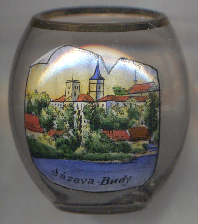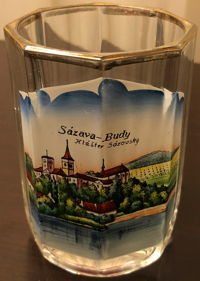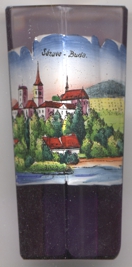

|
| ČESKÁ REPUBLIKA | CZECH REPUBLIC |
| Středočeský kraj | Central Bohemia region |
| Okres: Benešov |
Sázava (German: Sasau) is situated at an elevation of 312 m at the river Sázava about 40 km southwest of Prague and 12 km west of Uhlířské Janovice in the district Benešov. The municipality has a population of about 3,700 (2017) and also includes the villages of Bělokozly (Bielokosel), Černé Budy (Klosterdorf), čeřenice (Tscherschenitz) und Dojetřice (Dojetritz).
The settlement began to develop around Sázava Monastery, established 1032 and destroyed in the Hussite Wars, in 1421. The village near the monastery is recorded as early as 1053, and under the name Buda in 1788. The name Schwarz-Buda is recorded in 1844. The former village is now the western part of Sázava town, known as Černé Budy (German: Schwarzbuda or Klosterdorf), on the right bank of Sázava river. The municipality name, Sázava, is modern. The municipality was incorporated in 1850, as part of Kolín district. Jurisdiction lay with the Uhlířské Janovice (Kohljanowitz) district court until 1949. The municipality was transferred to Čáslav county in 1855, and to the district Kutná Hora in 1868, which in 1960 was included in the Central Bohemian Region. The municipality was transferred to the district Benešov in 2000.



 Sázava monastery (monasteryy of St. Procopius) was a Benedictine monastery,
established on the site of the hermitage of St. Procopius of Sázava (canonized in 1204).
Procopius attracted a community of hermits, which formed the basis of the Benedictine monastery established in 1032,
which thus is one of the oldest monasteries founded in the Duchy of Bohemia, some 40 years before Břevnov
monastery. The monks were expelled from the abbey in 1056 but could return in 1061. Unusually for a Benedictine abbey,
Sázava was an important center of Slavic, rather than Latin, liturgy until 1096. The first stone church, consecrated
to the Holy Cross, was built in 1070. The ruins of this church have been excavated and are visible in the garden north of
the monastery building. In 1096, the monks were expelled for the second time, marking the end of the Slavic rite in
Bohemia. The Slavic Benedictines were replaced by Latin Benedictines from Břevnov Monastery. In the 12th century,
the Romanesque basilica and monastery buildings were completed. A 12th-century chronicle records the history of the
monastery up to the year 1177. In the late 13th to 14th centuries, the Romanesque basilica was transformed into a Gothic
one, intended as a monumental three-nave structure, which however remained unfinished. The monastery buildings were also
rebuilt in the Gothic style. The Madonna of Sázava is a notable 14th-century fresco in the capitular hall, unusually
depicting Mary, mother of Jesus walking alongside a child Jesus aged about five years old. Sázava was sacked by
Hussite troops in 1421 and the monks were expelled, interrupting building activity. Over the following two centuries, the
monastery had secular owners and fell into decay. In 1664, the monastery was again revived and the dilapidated buildings
were reconstructed in the Baroque style. A fire in 1746 damaged the Baroque buildings, which were restored under architect
Kilian Ignatius Dientzenhofer in the late Baroque or Rococo style. The monastery was finally closed down by decree of
Emperor Joseph II in 1785. The monastery domain again fell to secular owners from 1809 who used the cloister as a
cháteau, while the basilica remained in operation as a parish church. Reconstructions of the monastery in
neo-Renaissance style were carried out after 1869. A revival of the monastery was planned after 1932, but World War II
and the following Communist regime interrupted the plan. The complex was managed by the National Cultural Committee of
Czechoslovakia from 1951. In 1962, the area became a National Cultural Heritage Site, managed by the National Heritage
Institute. Following the establishment of the Czech Republic, the property was restored to the heirs of the last private
owners who sold it to the state in 2006. Under the 2013 act on church restitution, parts of the domain were returned to the
Roman Catholic parish of Černé Budy (Sázava) and parts to Emmaus Monastery. The National Heritage Institute
remains in charge of restoration and conservation, focussing on the threatened pillars of the unfinished Gothic three-nave
structure and on the restoration of the baroque frescos.
Sázava monastery (monasteryy of St. Procopius) was a Benedictine monastery,
established on the site of the hermitage of St. Procopius of Sázava (canonized in 1204).
Procopius attracted a community of hermits, which formed the basis of the Benedictine monastery established in 1032,
which thus is one of the oldest monasteries founded in the Duchy of Bohemia, some 40 years before Břevnov
monastery. The monks were expelled from the abbey in 1056 but could return in 1061. Unusually for a Benedictine abbey,
Sázava was an important center of Slavic, rather than Latin, liturgy until 1096. The first stone church, consecrated
to the Holy Cross, was built in 1070. The ruins of this church have been excavated and are visible in the garden north of
the monastery building. In 1096, the monks were expelled for the second time, marking the end of the Slavic rite in
Bohemia. The Slavic Benedictines were replaced by Latin Benedictines from Břevnov Monastery. In the 12th century,
the Romanesque basilica and monastery buildings were completed. A 12th-century chronicle records the history of the
monastery up to the year 1177. In the late 13th to 14th centuries, the Romanesque basilica was transformed into a Gothic
one, intended as a monumental three-nave structure, which however remained unfinished. The monastery buildings were also
rebuilt in the Gothic style. The Madonna of Sázava is a notable 14th-century fresco in the capitular hall, unusually
depicting Mary, mother of Jesus walking alongside a child Jesus aged about five years old. Sázava was sacked by
Hussite troops in 1421 and the monks were expelled, interrupting building activity. Over the following two centuries, the
monastery had secular owners and fell into decay. In 1664, the monastery was again revived and the dilapidated buildings
were reconstructed in the Baroque style. A fire in 1746 damaged the Baroque buildings, which were restored under architect
Kilian Ignatius Dientzenhofer in the late Baroque or Rococo style. The monastery was finally closed down by decree of
Emperor Joseph II in 1785. The monastery domain again fell to secular owners from 1809 who used the cloister as a
cháteau, while the basilica remained in operation as a parish church. Reconstructions of the monastery in
neo-Renaissance style were carried out after 1869. A revival of the monastery was planned after 1932, but World War II
and the following Communist regime interrupted the plan. The complex was managed by the National Cultural Committee of
Czechoslovakia from 1951. In 1962, the area became a National Cultural Heritage Site, managed by the National Heritage
Institute. Following the establishment of the Czech Republic, the property was restored to the heirs of the last private
owners who sold it to the state in 2006. Under the 2013 act on church restitution, parts of the domain were returned to the
Roman Catholic parish of Černé Budy (Sázava) and parts to Emmaus Monastery. The National Heritage Institute
remains in charge of restoration and conservation, focussing on the threatened pillars of the unfinished Gothic three-nave
structure and on the restoration of the baroque frescos.
[https://de.wikipedia.org/wiki/Sázava, https://en.wikipedia.org/wiki/Sázava_(town);
https://de.wikipedia.org/wiki/Kloster_Sázava, https://en.wikipedia.org/wiki/Sázava_Monastery]
![[scale]](lineal.jpg)